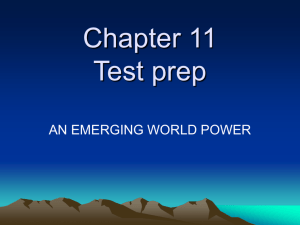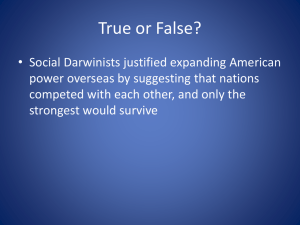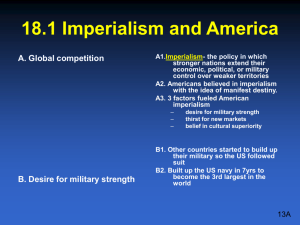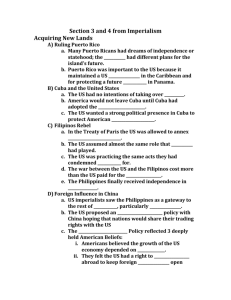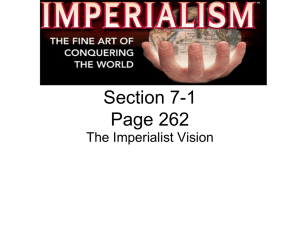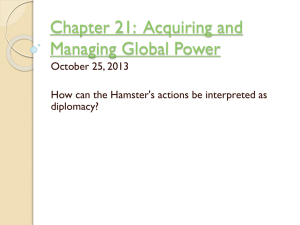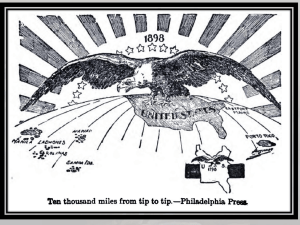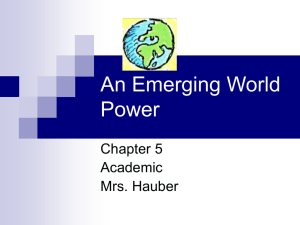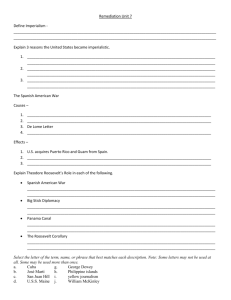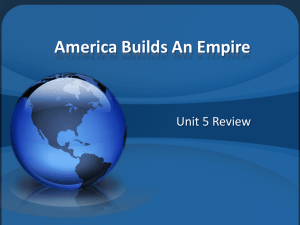Chapter 10: America Claims and Empire
advertisement
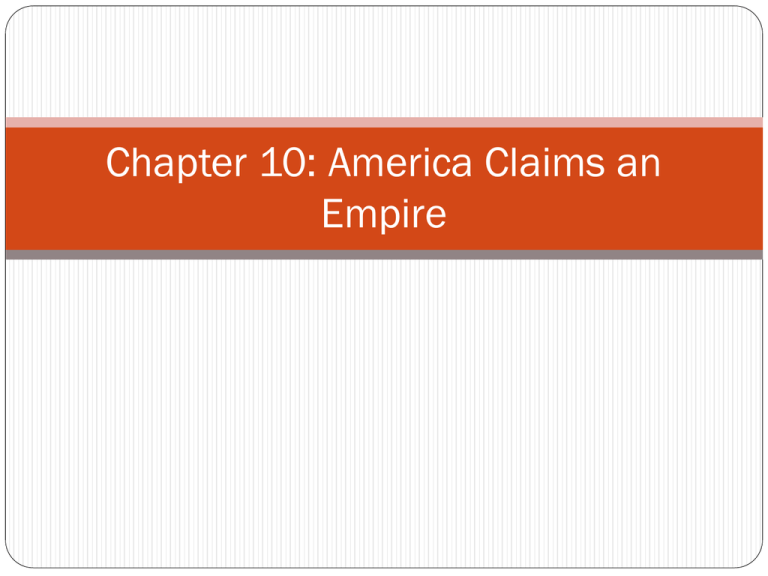
Chapter 10: America Claims an Empire Objective To understand how individuals and events moved the United States into the role of a world power and to recognize the effects of economic policies on U.S. diplomacy Journal When should the U.S. intervene in the affairs of another country? Imperialism The policy in which stronger nations extend their economic, political, or military control over weaker territories Global Competition Global Competition Three Factors Fueled American Imperialism 1. Desire for military strength 2. Thirst for new markets 3. Belief in cultural superiority Desire for Military Strength Admiral Alfred T. Mahan of U.S. Navy urges govt. to build up American naval power Modern battleships Maine and Oregon Thirst for New Markets Better technology -> farms + factories overproduced -> new markets needed for agricultural and manufactured goods U.S. needed raw materials for factories Belief in Cultural Superiority Social Darwinism – survival of the fittest Racial superiority of Anglo-Saxons Moral responsibility to spread Christianity Acquiring Alaska Seward – Sec. of State – persuades Congress to buy Alaska (1867) The U.S. Takes Hawaii Important port on the way to Asia U.S. imports Hawaii sugar tax-free (1875) McKinley-Tariff of 1890 palaces tax on Hawaiian sugar American planters ask U.S. to annex Hawaii Naval base at Pearl Harbor (1887) The U.S. Takes Hawaii Queen Liliuokalani (1891) wants to remove property qualifications for voting American business groups organize a revolution New govt. led by Sanford B. Dole 1898 Hawaii is named American territory Statehood = 1959 Assignment What were the economic and cultural factors that fueled the growth of American imperialism? How did the U.S. acquire Alaska? How did the U.S. acquire Hawaii? http://www.history.com/topics/spanish-american- war/videos#mckinley-faces-war-assassination Groups 1. http://edsitement.neh.gov/lesson-plan/spanish- american-war#sect-preparation Section 2 THE SPANISH – AMERICAN WAR Cubans Rebel Against Spain Cubans Rebel Against Spain Jose Marti starts a revolution (1895) against the Spanish American sugar plantations are destroyed American opinions are split War Fever Escalates Spanish General Valeriano Weyler sends 300,000 Cubans into concentration camps (1896) Yellow Journalism Sensational style of writing/exaggerated news Hearst’s NewYork Journal vs. Pulitzer’s NewYorkWorld “You furnish the pictures and I’ll furnish the war” – Hearst War Fever Escalates Pres. McKinley wants to avoid war with Spain de Lome (Spanish minister) writes letter and calls McKinley “weak” War with Spain Erupts “Remember the Maine!” 260 Americans die when U.S.S. Maine explodes U.S. declares war on Spain War with Spain George Dewey (Navy Admiral) takes over Philippines Filipino rebels led by Emilio Aguinaldo aid the Americans Naval blockade of Cuba 125,000 volunteers with inadequate supplies fought Rough Riders, cavalry unit led by T. Roosevelt, and two African American regiments take San Juan Hill Spain loses Cuba and then Puerto Rico War with Spain Erupts Treaty of Paris ends the war in 1898 U.S. buys Philippines (then annexes it) and Spain hands over Guam and P. Rico Assignment Page 351 Questions 2,3, and 4 Panama Canal http://www.pbs.org/wgbh/americanexperience/films/pan ama/player/ 12/9 – Journal 1. What is imperialism? 2. Why did the U.S. get involved? 3. What were the three factors that pushed the Americans into becoming an imperial power? 4. What lands did we take over first? 5. What happened with Hawaii? 6. What triggered the Spanish-American War? 7. What lands do we acquire? Section 3: Acquiring New Lands Ruling Puerto Rico Controlled by U.S. military Strategic importance = close to Panama 1900 Foraker Act = ends military rule, U.S. Pres. appoints governor of P. Rico 1917 American citizenship for P. Ricans Now -> P. Rico is a commonwealth move freely, cannot vote in. presidential elections Cuba Officially independent Occupied by American military troops 1901- Platt Amendment Cuba could not make treaties that might limit its independence or permit a foreign power to control any part of its territory The U.S. reserved the right to intervene in Cuba Cuba was not to go into debt The U.S. could buy or lease land on the island for naval stations and refueling stations Cuba Becomes a U.S. protectorate – a country whose affairs are partially controlled by a stronger power American businesses = sugar, tobacco, mining, railroads Philippine-American War U.S. annexes the Philippines Emilio Aguinaldo feels betrayed and organizes revolt 1899-1903 200,000 Filipino civilians die 20,000 Filipino rebels 4,000 Americans die (many African Americans) Cost $400 million U.S. sets up govt. and selects a governor Philippines become independent in 1946 China European nations had spheres of influence U.S. Secretary of State, John Hay, issues Open Door notes (1899) Letters addressed to leaders of imperialistic nations supporting open trade China Boxer Rebellion (1900) Secret societies kill thousands of missionaries and foreigners International forces put down rebellion A new Open Door note -> 1. U.S. economy depended on exports, 2. U.S. had right to intervene abroad to keep markets open The Impact of U.S. Territorial Gains Anti-Imperialist League – U.S. should not rule other people without their consent 1900 –William McKinley, an imperialist, is reelected Discussion Questions 1. Why was Puerto Rico important to the U.S.? 2. Why did the Filipinos rebel? 3. Why did Secretary of State John Hay issue the policy statements known as the Open Door notes? Section 4:America as a World Power Teddy Roosevelt and the World 1904 Tsar Nicholas II of Russia declares war on Japan Japan is defeating the Russians but runs out of money T. Roosevelt arranges a deal Japan takes over Russian land in Korea and Manchuria but takes back the cash payment Teddy Roosevelt and the World Panama Canal = greatly reduce travel time for commercial and military ships U.S. buys French company route for $40 million Philippe Bunau-Varilla, French agent, helps organize Panamanian rebellion against Colombia U.S. pays Panama $10 million and annual rent of $250,000 Constructing the Canal 1904-1914 Malaria, yellow fever, soft volcanic soil $380 million 5,600 workers died from accidents or disease Damaged U.S. relations with Latin America even with $25 million payment to Colombia Roosevelt Corollary Latin American nations took out loans from European banks 1904 Roosevelt adds the Roosevelt Corollary to the Monroe Doctrine = U.S. would use force to protect its economic interests in L. America Dollar Diplomacy Pres. Taft supported American business owners/bankers loaning money to L. American countries to pay off debts to Europeans Woodrow Wilson’s Missionary Diplomacy U.S. has moral responsibility to deny recognition to any L. American govt. it viewed as oppressive, undemocratic, anti-U.S. (1913) Mexican Revolution Porfirio Diaz, military dictator, encouraged foreign investments Americans owned Mexican oil wells, mines, railroads 1911 – Francisco Madero organizes a group of peasants/workers to overthrow Diaz General Huerta orders execution of Madero and takes control of govt. Wilson will not recognize the new Mexican govt Wilson sends troops to occupy Veracruz (Mexican port) after American sailors are arrested near by Venustiano Carranza becomes Pres. Of Mexico in 1915 and U.S. removes troops Rebellion in Mexico Francisco “Pancho” Villa and Emiliano Zapata opposed Carranza’s govt. Zapata = land reform Villa = against foreign powers in Mexico Followers killed 17 Americans in New Mexico Pres. Wilson orders General John J. Pershing to capture Villa 150,000 National Guardsmen stationed at Mexican border U.S. and Mexican troops clash With a war in Europe to fight Americans back off Questions Section 4 1. Using American Power (list ways they used American power around the world during their presidency) 2. What do you think were the similarities and differences between Roosevelt’s Big Stick Policy and Wilson’s missionary diplomacy? the goal of each of these foreign policies How the policies defined the role of U.S. intervention in international affairs How the policies were applied
